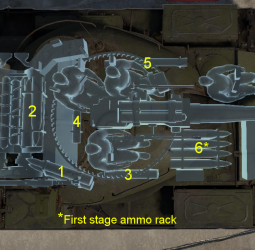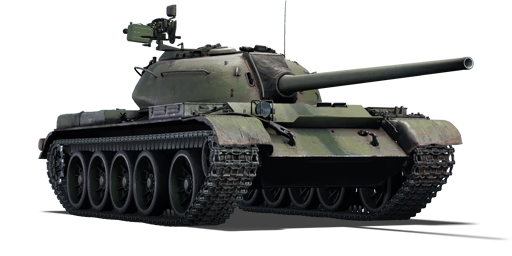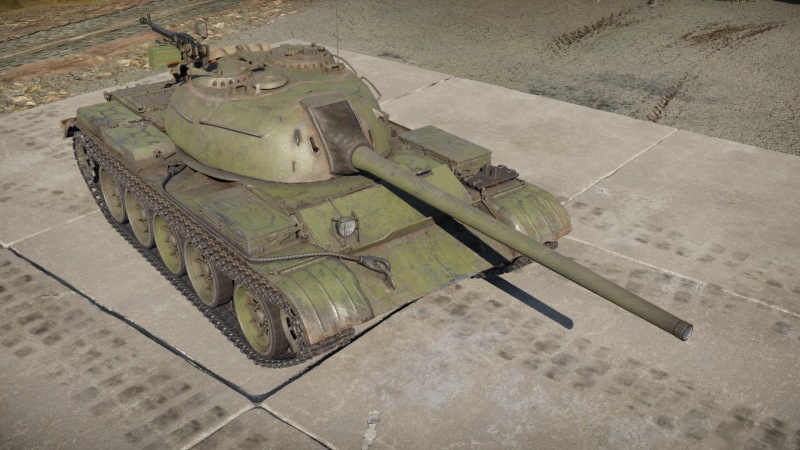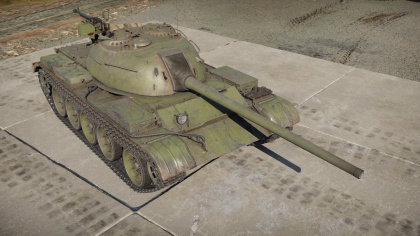T-54 (1949)
Contents
Description
The T-54 (1949) is a rank V Soviet medium tank
with a battle rating of 8.0 (AB/RB/SB). It was introduced in Update 1.47 "Big Guns". It is the second in the Soviet T-54 series between the 1947 and 1951 models, yet only differs in the design and the available choice in ammunition.
General info
Survivability and armour
Armour type:
- Rolled homogeneous armour (Hull, Turret roof)
- Cast homogeneous armour (Turret)
| Armour | Front | Sides | Rear | Roof |
|---|---|---|---|---|
| Hull | 100 mm (61°) Front glacis 100 mm (53°) Lower glacis |
80 mm | 45 mm (18°) Upper 30 mm (73°) Lower |
30 mm |
| Turret | 200 mm (7-64°) Turret front 200 mm Gun mantlet |
90 - 160 mm (9-48°) | 50 mm (16-52°) | 30 mm |
| Armour | Sides | Roof | ||
| Cupola | 100 mm | 30 mm |
Notes:
- Suspension wheels are 20 mm thick while tracks are 18 mm thick.
Mobility
| Game Mode | Max Speed (km/h) | Weight (tons) | Engine power (horsepower) | Power-to-weight ratio (hp/ton) | |||
|---|---|---|---|---|---|---|---|
| Forward | Reverse | Stock | Upgraded | Stock | Upgraded | ||
| Arcade | 56 | 9 | 35.5 | 806 | 992 | 22.7 | 27.94 |
| Realistic | 51 | 8 | 460 | 520 | 12.96 | 14.65 | |
Modifications and economy
Armaments
Main armament
| 100 mm D-10T | Turret rotation speed (°/s) | Reloading rate (seconds) | |||||||||||
|---|---|---|---|---|---|---|---|---|---|---|---|---|---|
| Mode | Capacity | Vertical | Horizontal | Stabilizer | Stock | Upgraded | Full | Expert | Aced | Stock | Full | Expert | Aced |
| Arcade | 34 | -4°/+17° | ±180° | N/A | 9.5 | 13.2 | 16.0 | 17.7 | 18.8 | 11.05 | 9.78 | 9.01 | 8.50 |
| Realistic | 5.9 | 7.0 | 8.5 | 9.4 | 10.0 | ||||||||
Ammunition
| Penetration statistics | |||||||
|---|---|---|---|---|---|---|---|
| Ammunition | Type of warhead |
Penetration @ 0° Angle of Attack (mm) | |||||
| 10 m | 100 m | 500 m | 1,000 m | 1,500 m | 2,000 m | ||
| BR-412 | APHE | 218 | 213 | 192 | 169 | 148 | 130 |
| BR-412B | APHEBC | 218 | 214 | 195 | 173 | 154 | 137 |
| BR-412D | APCBC | 239 | 236 | 223 | 207 | 192 | 178 |
| BR-412P | APCR | 224 | 216 | 186 | 153 | 127 | 105 |
| 3BM-8 | APDS | 299 | 298 | 291 | 272 | 253 | 249 |
| OF-412 | HE | 19 | 19 | 19 | 19 | 19 | 19 |
| Shell details | |||||||||
|---|---|---|---|---|---|---|---|---|---|
| Ammunition | Type of warhead |
Velocity (m/s) |
Projectile Mass (kg) |
Fuse delay (m) |
Fuse sensitivity (mm) |
Explosive Mass (TNT equivalent) (g) |
Ricochet | ||
| 0% | 50% | 100% | |||||||
| BR-412 | APHE | 895 | 15.9 | 1.2 | 19 | 100.1 | 47° | 60° | 65° |
| BR-412B | APHEBC | 895 | 15.9 | 1.2 | 19 | 100.1 | 47° | 60° | 65° |
| BR-412D | APCBC | 887 | 15.9 | 1.2 | 19 | 93.94 | 48° | 63° | 71° |
| BR-412P | APCR | 1,050 | 8.53 | N/A | N/A | N/A | 66° | 70° | 72° |
| 3BM-8 | APDS | 1,415 | 4.13 | N/A | N/A | N/A | 75° | 78° | 80° |
| OF-412 | HE | 900 | 15.6 | 0 | 0.1 | 1,460 | 79° | 80° | 81° |
| Smoke shell characteristics | ||||||
|---|---|---|---|---|---|---|
| Ammunition | Velocity (m/s) |
Projectile Mass (kg) |
Screen radius (m) |
Screen deploy time (s) |
Screen hold time (s) |
Explosive Mass (TNT equivalent) (g) |
| 3D3 | 880 | 15.6 | 20 | 5 | 25 | 272 |
Ammo racks

| Full ammo |
1st rack empty |
2nd rack empty |
3rd rack empty |
4th rack empty |
5th rack empty |
Visual discrepancy |
|---|---|---|---|---|---|---|
| 34 | 29 (+5) | 26 (+8) | 25 (+9) | 21 (+13) | 1 (+33) | No |
Notes:
- Turret empty: 26 (+8) shells.
- Last rack only: 21 (+13) shells.
Machine guns
| 12.7 mm DShK | ||||
|---|---|---|---|---|
| Mount | Capacity (Belt) | Fire rate | Vertical | Horizontal |
| Pintle | 250 (50) | 600 | -10°/+60° | ±180° |
| 7.62 mm SGMT | ||||
|---|---|---|---|---|
| Mount | Capacity (Belt) | Fire rate | Vertical | Horizontal |
| Coaxial | 3,500 (250) | 600 | N/A | N/A |
Usage in battles
The T-54 '49 is an upgraded version of the T-54 '47, it has a turret without the shot-trap, and it has generally more armour, however this is counteracted with weaker hull armour, and this does make a difference for some early APFSDS and some HEAT rounds (the War Thunder community generally accepts the T-54 '47 as having the best armour overall). Another upgrade is the new APDS round, which has superior penetration. This round should be used to take on only the most armoured targets frontally because it does minimal damage - BR-412D still is considered the better round because it has enough penetration and it one-shots easily.
General Playstyle
The T-54 '49 continues in the steps of its predecessor, still being a Jack-of-All-Trades tank, on the same platform with the same gun. Importantly, it has improved turret armour, although at the cost of hull armour, which promotes hull-down gameplay. In Arcade, the T-54 '49 retains the mobility of the T-54 '47, but now you have the back-up option of using APDS. (Read the T-54 '47 article, as it covers general playstyle with more depth)
Major Gameplay Differences from the T-54 '47 (Read the T-54 '47 article prior to reading this!)
- You are now able to snipe more accurately, because of your APDS round that goes over 1,400 m/s. This can be taken advantage of at the start of matches, especially in Realistic Battles.
- Your upgraded turret is now able to outright block some rounds, especially at Battle Ratings 6.7 - 7.0, and it's not worth wiggling or angling it.
The Stock Grind
When grinding the first modifications, Arcade Battles might be more fun, because of faster-paced gameplay and the ability to see all threats. Now, it's a priority to research Parts and FPE. (Activating universal back-ups for this vehicle to speed up the grind is an option, but it is not an exceptional vehicle, and it's best to just research the T-54 '51, as it has more ammunition choices).
General tips for the stock grind are the same as those for the T-54 '47, read that article.
Modules
| Tier | Mobility | Protection | Firepower | |||
|---|---|---|---|---|---|---|
| I | Tracks | Parts | BR-412B | Horizontal Drive | ||
| II | Suspension | Brake System | FPE | Adjustment of Fire | Smoke grenade | |
| III | Filters | Crew Replenishment | BR-412D | Elevation Mechanism | BR-412P | |
| IV | Transmission | Engine | Artillery Support | 3BM-8 | 3D3 | |
After Parts and FPE, the player should focus on mobility upgrades or the Horizontal Drive modification, since both mobility and turret rotation are limited when the tank is stock.
Pros and cons
Pros:
- Retains the decent D-10 100 mm gun, just like the T-54 (1947)
- Access to APDS ammunition
- Fast reload rate
- New elliptical turret removes the frontal turret shot trap found on the T-54 (1947)
- Good mobility
Cons:
- Armour is not as thick in comparison to the T-54 (1947)
- Angling the armour is not advised, as the side armour will be exposed
- Ammo Racks can be detonated fairly easily from the side
- Slow turret traverse speed in general
History
Predecessors
During World War II, the Soviet Union fielded the T-34 in large numbers to overrun the German tanks. The initial T-34 variant with the 76 mm gun soon became insufficient due to further German development on potent anti-tank weaponry. The response was the development of the T-34-85 with the more powerful 85 mm gun. However, the T-34-85 was still insufficient fighting against the German "big cats" tanks. This prompted for further tank development to make a more protected medium tank for the Soviet armoured forces. This developed into the T-44, which proved superior to the T-34 in armour, but retained the same 85 mm gun.
Development
The army then requested that the gun on the tank be increased for additional firepower. This developed into adding the 100 mm gun onto the T-44 and was designated the T-44-100. The T-44-100 proved successful in testing, but still suffered drawbacks that impeded its efficiency. It was decided that instead of quickly sending the tank into production, further development and modernization on the overall tank design should be made to make the tank the full transition from a World-War-II-era tank into the next generation. This developed into the T-54 tank that was accepted into service on 29 April 1946.
The tank would enter production at Nizhni Tagil in 1947 and Kharkov in 1948. However, the initial production was slow as the serial production models underwent 1,490 different modifications. The first model produced was designated the T-54-1 (Object 137), which had a thicker hull armour than its future model. This production model suffered a quality deficiency, and was cancelled and upgraded into the T-54-2 (Object 137R) in 1949 that featured a new turret and other changes to the hull, transmission, and track design. In 1951, another change was made to the design and was designated the T-54-3 (Object 137Sh). The T-54-3 design featured a new turret design that removed shot traps. New gun sight and the smoke generating system were also installed into the tank. The T-54-3 would become the basis of future T-54 design, with the turret design staying in all of its successors.
Despite the T-54's great performance in its design, the T-54 did not stop at its base model. The first upgrades done was in 1953 and 1955 when the tank's D-10 gun was given stabilization gear, first with a vertical stabilizer in 1953 before upgrading again with a 2-plane stabilizer in 1955. These tank upgrades renamed the T-54 to T-54A and T-54B for the respective years. While an improvement in the tank's performance, the biggest jump came with the advent of nuclear technology in the Soviet arsenal. When testings show that a T-54 can survive the blast of a 2 - 15 kt nuclear charge at 300 meters (700 m for crew survival), the T-54 was slated for the instalment of a Nuclear, Biological, and Chemical (NBC) protection system to protect the crew from the weapons of mass destruction. This project was given to the KB-60 design bureau in Kharkov and this was finished in 1956. Along with many other changes to the tank interior, such as a new engine, heating system, fuel tanks, ammo storage, and new guns sights, the tank became the more common T-55 tank, which would replace the T-54 design in production past 1958. The difference in the T-54 and the T-55 other than the mechanical differences is the presence of a dome-shaped ventilator in front of the loaders hatch, it is a T-54 if present as it was removed in order to seal the tank with NBC protection. All in all, the T-54/55 tank series became the most widely produced tank ever, surpassing the T-34 with an estimated 100,000+ built, many due to the export market and licensed manufacturing the Soviets gave to their allies.
Design
The T-54 is a simple and reliable, yet deadly machine compared to its contemporaries at its introduction. The T-54 retained the same interior compartments as traditional designs, with the driving in the front, fighting and turret in the centre, and the engine at the rear. The most distinctive features on the T-54 is the dome turret and the space between the first and second road wheels in the front, which would be absent in its successor, the T-62.
The T-54 simplicity and reliability made it a very easy tank to operate, not requiring a thoroughly trained crew to operate (though a better crew can give better performance). The T-54 also presents a very low profile compared to the American and British tank, which makes it a smaller target to hit. The lightweight of the design at only 36 tons made it very easy to transport around on flatbed. The tank also features extra abilities like a cold-weather starting system and a snorkel for deep-wading that were mostly absent on similar vehicles. Finally, the 100 mm D-10T gun was much better than anything fielded as tank armament, able to defeat the American Patton and the British Centurions, which were their mainstay tanks. Even after the introduction of superior tanks like the M60 tank with the 105 mm M68 gun, the T-54 is able to keep up with new HEAT and APDS rounds.
However, the T-54 design suffered from some of these advantages. The small profile gave the tank a small interior volume, which causes such a constraint to crew space that a height limit had to be set. The low turret silhouette also made the tank unable to depress the gun in a large angle due to the gun's breech hitting the roof, which restricts the T-54 ability to enter a hull-down position. Like other tanks in its generation, the T-54 also had unprotected ammo storage, which increased the chance of a catastrophic explosion of the ammunition if the tank is penetrated in battle.
Despite that, the T-54 design, upgraded into the T-55, proved very successful as a cost-effective weapon of war that can still stand on its own today. Its utility is further demonstrated by the many variants created from the chassis, such as bridge-layers, fire-fighting vehicles, flamethrowers, armoured-personnel carriers, engineer vehicles, and anti-aircraft vehicles.
Combat usage
Most of the service recorded in the T-54 and the T-55 are interchangeable as the two are essentially identical aside from the NBC protection. They will be referred to as the "T-54/55" unless specified otherwise.
The Soviets main tank during the course of the Cold War was the T-54/55 and the T-62 tanks, comprising about 85% of the Soviet armoured force in the mid-1970s. The first combat usage of the T-54 was in the Hungarian Revolution of 1956. During the conflict, one T-54A was captured by the Hungarian rebels and delivered it to the British embassy. This act inspired the production of the 105 mm L7 gun and the M60 MBT when tests on this T-54 found it superior in firepower and armour. Afterwards, the Soviets did not have many activities with the T-54/55, but they are still in reserve status after being replaced by the Soviet T-72 and T-90 tanks.
The Middle East region saw more usage of the T-54/55 in the conflicts that ensured there, notably in the Israel-Arab conflicts in the Six-Day War and the Yom Kippur War. Israel was able to beat back the T-54/55 in both conflicts due to superior tactics and air superiority in the Six-Day War, and the presence of superior tanks such as the 105 mm equipped M60 and Centurion tanks, which could more easily deal with the T-54/55 in the Yom Kippur War. Israel was able to capture many T-54/55 tanks intact in both wars and upgraded these tanks with the 105 mm L7 gun, designated as the Tiran-5. The T-54/55 also saw usage in the Jordanian Civil War of 1970 on the Syrian side, the Iran-Iraq War in the 1980s, and even as recent as Operation Desert Storm in 1991 and Operation Iraqi Freedom in 2003, a testament to the utility and reliability of the T-54/55 tanks to still be in use 60 years after its introduction despite its inferiority to the American M1A1 Abrams and the British Challenger II's.
The T-54/55 also saw use in the Vietnam War on the North Vietnamese side, equipping the NVA 203rd Armoured Regiment and many other divisions. The T-54/55 also made an appearance in Angola and Mozambique, which were supplied from the Soviets to support the rising Marxist influences in South Africa. These T-54/55s saw use in the South African Border War and Angolan Civil War, but many were lost against the turreted armoured car with HEAT rounds. Many other countries in the world used the T-54/55 as well, whether given by the Soviets and their allies or licensed to produce in-country, up to 50 countries in the world used the T-54/55 in their military, including irregular forces in these countries. Notable conflicts using the T-54/55 was in the Indo-Pakistani War in the Indian Army, in the Ugandan-Tanzanian War, Yugoslav Wars, Sino-Vietnamese War, and the Sri Lankan Civil War. The T-54/55 is still being used today in the modern century, such as the Libyan Civil War in 2011, and the ongoing conflicts of the Syrian Civil War in many sides, including ISIS and the Syrian Army.
In-game description
The tank received a streamlined cast turret with an improved shape designed to reduce ricochets to the hull roof. Its weapon was equipped with a new gun mantlet. One fender-mounted SG-43 machine gun was removed from the driver's compartment. The upper frontal hull plate was reduced to 100 mm thickness and the lower armour plate's slope was increased. The engine cooling system was modernised. The 500 mm wide tracks were replaced by new 580 mm wide tracks, which reduced ground pressure to acceptable levels.
The tank's wheels received independent torsion-bar suspension, reducing its weight by 1,700 kg. This lead to a significant increase in the tank's durability, a height reduction of 30 cm and an increase in its driving performance. The T-54's armoured hull was fully welded from rolled plates and homogenous steel sheets.
The tanks were manufactured until 1951, and around 2,523 of them were made.
The T-54 tank was noted for its adequate mobility, well-designed hull and turret and greater firepower in comparison to vehicles of this class made by other countries.
However, although the hull's configuration ensured the Soviet tank's advantages over its foreign counterparts, it also restricted opportunities for further increasing the tank's defences, particularly against the new 90 and 105 mm high-explosive anti-tank warheads and armour-piercing subcalibre rounds. The unstabilised 100 mm D-10T tank cannon's accuracy and rate of fire were too low when firing on the move. In addition, it became necessary to introduce new armour-piercing subcalibre rounds and high-explosive rounds in particular to the cannon's ammunition complement.
These vehicles served in the armies of the former Warsaw Pact member states. Additionally, they were supplied to many countries in Asia and the Middle East.
Media
- Skins
- Videos
See also
- T-54 (1947) - Predecessor, featuring an enhanced front glacis plate, but turret design has certain frontal weak points.
- T-54 (1951) - Successor, featuring an improved turret design that eliminates the rear shot trap.
External links
| USSR medium tanks | |
|---|---|
| T-28 | T-28 (1938) · T-28 · T-28E |
| T-34-76 | T-34 (Prototype) · T-34 (1940) · T-34 (1941) · T-34 (1st Gv.T.Br.) · T-34 (1942) · T-34E STZ · T-34E |
| T-34-57 | T-34-57 · T-34-57 (1943) |
| T-34-85 | T-34-85 (D-5T) · T-34-85 · T-34-85E |
| T-34-100 | T-34-100 |
| T-44 | T-44 · T-44-100 · T-44-122 |
| T-54 | T-54 (1947) · T-54 (1949) · T-54 (1951) |
| T-55 | TO-55 · T-55A · T-55AM-1 · T-55AMD-1 |
| T-62 | T-62 · T-62M-1 |
| T-64 | Object 435 · T-64A (1971) · T-64B |
| T-72 | T-72A · T-72AV (TURMS-T) · T-72B · T-72B (1989) · T-72B3 · T-72M2 Moderna |
| T-80 | T-80B · T-80U · T-80UD · T-80UK · T-80UM2 · Т-80U-Е1 · T-80BVM · Object 292 |
| T-90 | Т-90А · T-90M |
| Trophies/Lend-Lease | |
| Germany | ▂T-III · ▂T-V |
| Great Britain | ▂МК-IX "Valentine" |
| USA | ▂M3 Medium · ▂M4A2 |






